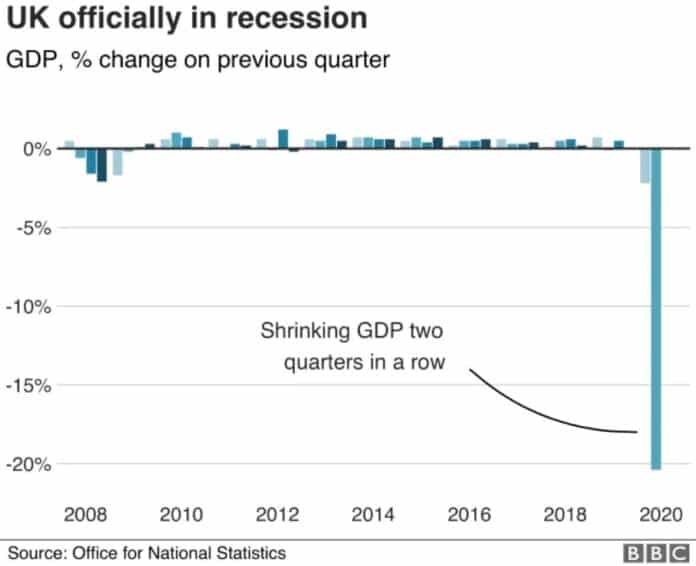So it’s official – Britain is in recession.
Except that this is unlike any recession any of us have experienced.
It is the deepest recession in modern British history.
It is the deepest of any other leading industrialised economy (only Spain’s economy shrank by more in the first half of 2020).
Indeed, this is the deepest recession since the invention of gross domestic product as an economic concept back in the 1930s.
In one sense the fall is not surprising: we were in lockdown for most of the second quarter, so it was always likely that economic output would fall sharply during that period.
The lockdown began in the first quarter and intensified in the second, and given the standard definition of a recession is two successive quarters of contraction, it was plain a while back that we would face a recession.
Even so, the scale of it is quite something: a 20.4% fall in output in the second quarter – almost double the fall in most other advanced economies.
It puts UK economic output back to the level it was in 2003: 16 years of growth and prosperity wiped out in the space of six months.
Except that’s not quite right, because this is no normal recession in another respect too. Mostly, recessions are thrust upon countries and governments.
This recession was, at least in part, a confected one: a lockdown designed to clamp down on activity and bring COVID-19 under control.
And the good news is that much of that economic output should come back pretty quickly.
Indeed, delve deeper into the figures released by the Office for National Statistics today – into the month-on-month growth rates, and you can see the early signs of that rebound.
Monthly GDP actually rose by 8.7% in June, the biggest monthly increase since records began.
It’s nowhere near enough to bring the level of income across the economy back to where it was before COVID-19 struck – indeed it still leaves GDP 17.2% shy of its pre-crisis level.
Still: for those who hope this will be V-shaped recovery, with a very quick rebound back to normality, it is a start.
Economic statistics are mostly the equivalent of a rear-view mirror.
These GDP numbers are history, albeit recent history – a cliff edge and a canyon we are now pulling out of. The abiding question now is what happens next.
Does the UK economy recover, or does economic activity drag on at a weaker rate for the foreseeable future? And, inextricably linked, what happens if there’s a second surge in COVID-19 infections: does it prompt another lockdown or semi-lockdown, with all the associated consequences?
Most economists suspect that whatever happens, unemployment will rise even more sharply than after the financial crisis in 2008, making this the biggest jobs crisis since the 1980s.
In the end, that statistic – unemployment – may prove more significant and meaningful than a double-digit fall in GDP.
The scale of this economic contraction is unlikely ever to be repeated.
It will take some time before we understand the precise shape of the curve: the ONS constantly revises these numbers over time, so it might be that the fall was less deep, or maybe deeper.
Is this the worst recession since 1921 or since the early 18th century? Only time will tell.
It is likely that it is an unusually short-lived recession, if only because the fall was so sharp that any return to a semblance of normality would involve an increase in output.
Even so, it is a baleful moment for the UK. It might just be a statistic, it might not be the best measure of personal wellbeing or equality, but GDP is still about the most comprehensive metric of a country’s welfare.
It is simply the sum total of everything we buy, sell or earn. And we have never seen it collapse like this before.
PLEASE COMPLETE SURVEY:







